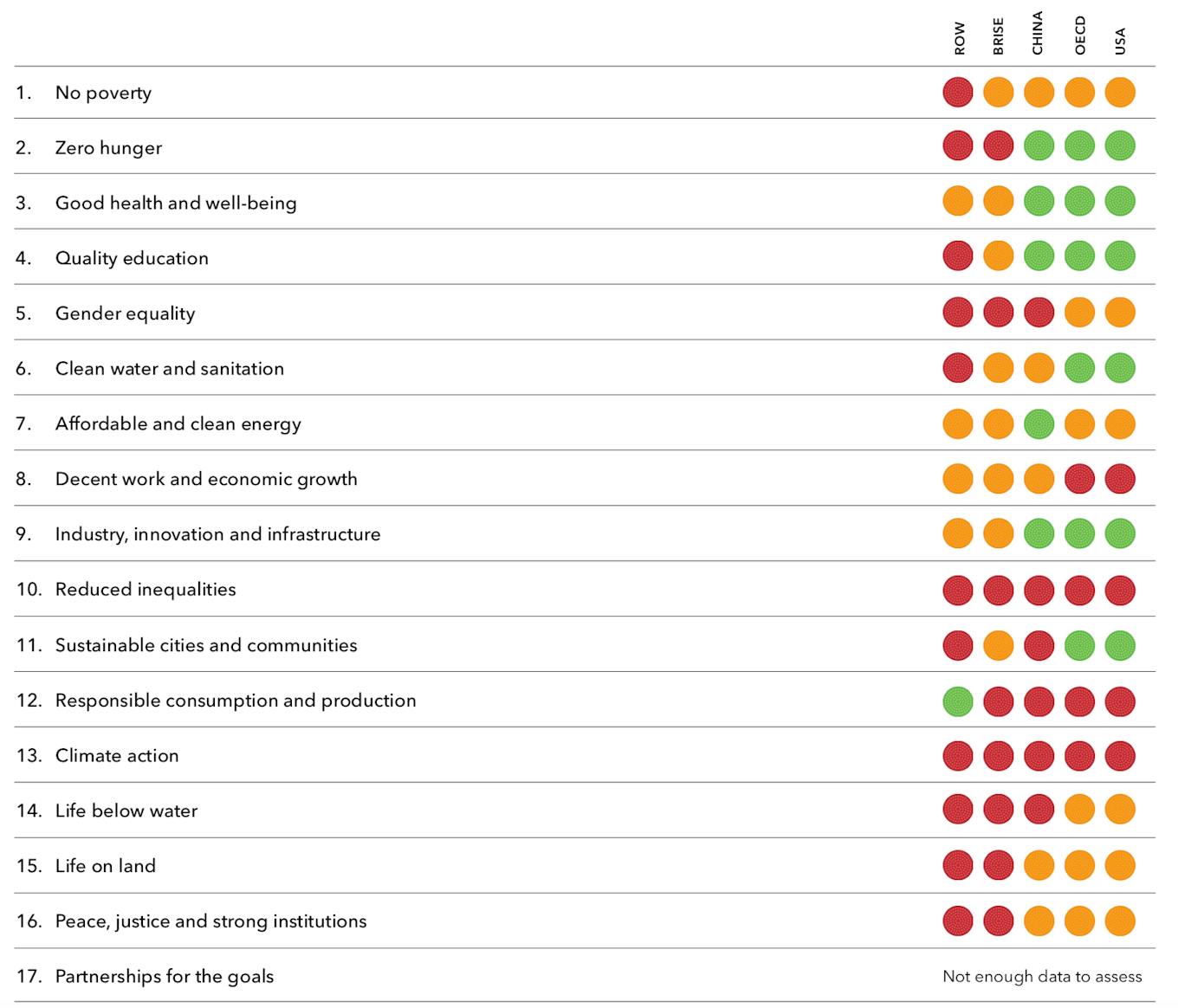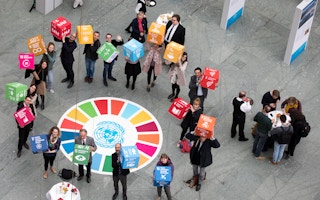Taking climate action, safeguarding life below water, reducing inequalities, and promoting responsible consumption and production: The global community adopted these four targets as part of the 17 Sustainable Development Goals (SDGs) it wants to achieve by 2030, but is likely to fail to do so unless the business community steps up to deliver solutions that will help achieve the goals.
To continue reading, subscribe to Eco‑Business.
There's something for everyone. We offer a range of subscription plans.
- Access our stories and receive our Insights Weekly newsletter with the free EB Member plan.
- Unlock unlimited access to our content and archive with EB Circle.
- Publish your content with EB Premium.
This is the verdict of the latest Global Opportunity Report, released on Thursday by Danish advisory group Sustainia, Norwegian energy and shipping advisory firm DNV GL, and the United Nations Global Compact (UNGC).
The report draws on a 2016 publication titled The Future of Spaceship Earth by DNV GL, which used a combination of three computational models to predict whether the world would meet the SDGs. The report found that while some goals such as improvements in health and affordable energy would be achieved in some parts of the world, others would remain unmet worldwide. These include goal 10 (reduced inequalities), goal 13 (climate action), and goal 14 (life below water).
But this disheartening forecast also presents major market opportunities for businesses to develop products and services which address risks such as environmental degradation and inequality, said the report, which also showcased examples of companies that are leading the way on delivering solutions for the SDGs.
As Remi Eriksen, group president and chief executive officer, DNV GL, put it: “The UN Sustainable Development Goals define the future desires of mankind. However, achieving them will not come without solving some fundamental challenges.”
Unlocking opportunities

A graphic by DNV GL showing the degree to which the SDGs are expected to be achieved in different parts of the world by 2030. Green means that goal is likely to be reached, orange indicates that the goal won’t be reached, but more than half of the gap between today’s status and the goal will be closed; and red means that the goal will not be met and little progress will be made. Image: Global Opportunities Report
For SDG 10, which aims to reduce inequality, the two main solutions the report identified involved developing a formal mechanism to recognise and protect land rights, and making global supply chains more transparent so that it is easier to track products from raw materials to stores, as well as monitor for labour, environmental or human rights violations.
When it comes to securing proof of land ownership—this is essential so that land cannot be snatched from its rightful owners via bribery, fraud, or other unethical practices—using blockchain technology can make it impossible to tamper with land registration, and make the process transparent, the report noted. However, it cautioned that blockchain must be accompanied by broader land reforms and policies which give women, the poor, and other marginalised people better access to land.
Globally, there are land assets worth about US$20 trillion that people do not have proof of ownership for, and in Sweden alone, the government stands to save US$106 million annually by eliminating land registration paperwork, the report pointed out. It also noted that 70 per cent of the global population does not have a legal record of the land they own, further underscoring the scale of the opportunity for solutions in this space.
Examples of companies that have already made strides in this area include BenBen, a blockchain-powered land transaction platform in Ghana, and Uhurulabs, a Tanzanian company which uses drones to create accurate maps of land borders and ownership rights.
Blockchain and other technologies can also help companies and consumers alike gain better visibility into international supply chains, which in sectors such as food and retail, can be marred by unsustainable natural resource use and labour exploitation. Companies that have done so have already reaped the benefits, the report pointed out. For instance, when tuna brand John West introduced a way for consumers to trace tuna all the way back to fishermen who caught the fish, it increased sales by US$22 million.
Ultimately, there is a US$1.3 trillion opportunity for brands that make their sustainability credentials clear, and blockchain can help with this, said the report.
“
Through developing breakthrough innovations and forging critical partnerships, the business community has the resources and creativity we need to create the world we want.
Lise Kingo, chief executive officer and executive director, United Nations Global Compact
To advance SDG 12 on responsible consumption and production, solutions such as the circular economy—where resources are recovered and reused at the end of the product’s life cycle rather than discarded as waste—and dramatically different lifestyle choices such as eating insect protein need to be scaled up, the report recommended.
For the latter trend, the global market for edible insects was US$33 million in 2015, but is expected to soar to US$773 million by 2024, the report predicted, calling this alternative food source “a breakthrough market to watch”. Examples of companies already cashing in on this trend include Chirps Chips, a US-based firm which makes cookies and chips from cricket flour; and BiteBack, an Indonesian firm which extracts oil from edible insects as a sustainable alternative to palm oil. The edible oil has long been linked to driving deforestation and habitat loss in Indonesia and other tropical nations where it is cultivated.
Another SDG that is unlikely to be met anywhere in the world by 2030 is goal 13, climate action. “With the cost of climate change estimated to be anywhere between US$12 and US$60 trillion, there is clearly a huge opportunity for businesses everywhere to innovate and deliver low-carbon solutions,” noted the report.
Three areas that are especially promising are the conversion of the greenhouse gas carbon dioxide into useful products; finding more energy efficient solutions for air conditioning and refrigeration, and slashing carbon emissions in the shipping sector.
About US$1.1 trillion a year worth of opportunities await companies that upcycle carbon into products such as building materials, plastic containers, and construction materials, the report noted.
In addition to the climate, the long-term productivity and health of global marine resources—which is enshrined in SDG 14 (life below water)—is also in dire straits, thanks to threats such as marine plastic pollution and overfishing.
But finding ways to keep plastic in circulation for longer so that it doesn’t end up as waste can recover some US$120 billion, noted the report.
Aquaculture, the practice of farming fish and shellfish for human consumption, is also “the world’s fastest growing food industry”, having grown by 1,570 per cent in the last 40 years, the report said. It is expected to grow from US$176 billion today to US$219 billion by 2022, presenting opportunities not only to protect marine resources, but also to address hunger (Goal 2), and offer responsible food choices to consumers.
The complete set of solutions identified by the report is accessible in the project’s online Global Opportunity Explorer.
New opportunities, new models
Attractive as they are, cashing in on these SDG-linked market opportunities will require businesses to change the way they think and operate, noted the report.
For one thing, all businesses will have to embrace technological innovation, as it will play an increasing role in solving social and environmental challenges. The use of smart farming for food security, smart water technology to prevent water losses, and using sensors and mobile technology to deliver better healthcare are a few examples.
Second, cashing in on promising solutions will require companies to venture beyond their core area of business to explore adjacent or relevant sectors as well. For instance, professionals in the health and food sectors would have an overlapping interest in developing antibiotic-free food, a product for which there is growing global demand.
Nicholas Craig, analyst, Sustainia, told Eco-Business that “in practical terms, this means that corporate decision makers need to challenge business-as-usual practices and be more daring when entering new partnerships.” This is a recommendation reflected in SDG 17, which advocates for greater partnerships for the goals.
“Businesses need to become better at working together with other industries, civil society and government, who can challenge their mindsets,” he added.
Lise Kingo, chief executive officer and executive director, UNGC, said in a statement that “we live in a world in urgent need of change, and businesses are leading the charge towards the transformations ahead.”
She added: “Through developing breakthrough innovations and forging critical partnerships, the business community has the resources and creativity we need to create the world we want.”










